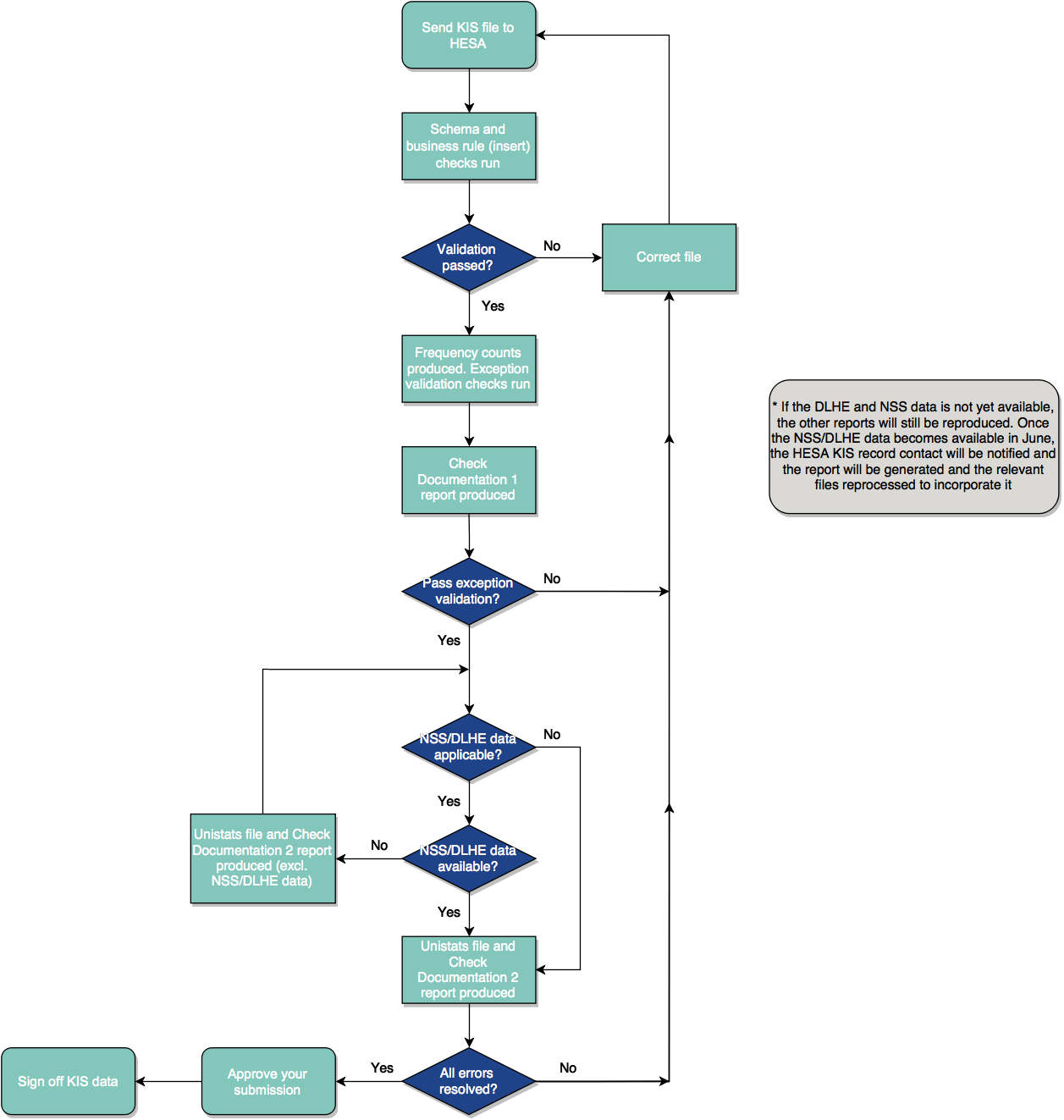Key Information Set 2016/17: Support guides
This page provides an overview of the 2016/17 Key Information Set (KIS) collection (C16061).
This should be used alongside the C16061 coding manual, which provides more detailed, technical information about the collection.
Need help? Contact us by email or on +44 (0)1242 211144
Key Information Set overview
We collect data across a number of streams. These streams focus on different aspects of higher education.
The Key Information Set (KIS) stream collects data about full-time and part-time undergraduate courses available for application for the next academic year. Details of what information needs to be returned to us are included in the Coverage document found in the Coding manual.
The data we collect on behalf of the sector is used in the government's Unistats tool. We also make data available to the public to enhance understanding of UK higher education and to support its advancement.
Our coding manuals provide you with all the necessary documentation to support your data return. The coding manual contains technical documents giving detailed information on the record's coverage, data specification and submission formats. Familiarising yourself with these documents will help you make an accurate and timely return.
Each collection has its own coding manual which can be found in the Data collection section of our site. By default, you will land on the open collection for each record; you can then select previous or future years.
The coding manuals will be updated throughout the data collection cycle and Record Contacts informed by email when new versions are made live. Be sure to check the manual's Revision history for a summary of changes.
You submit data via our Data Collection system. To access this, you will need to have an appropriate role in our Identity System (IDS). We publish an IDS user guide which includes information on creating and editing your account.
You will need to be given access to the Data Collection system by the relevant Record Contact at your provider.
Once you have access to the system you will be able to upload files and track the progress of the collection.
The coding manual homepage includes all the technical information you require, including:
- The data specification
- File format specifications
- A detailed collection schedule
- Our XML data entry tool (available for some streams)
- Quality rules.
This Support guides page collects together the following resources:
- User guide
- Data collection system: Known issues and release history.
In the Support area of the HESA website, you can find:
- User guides for our Identity System (IDS) and Issue Management System data quality database (HESA subscribers only).
- Support with using XML files
- Our XML amalgamator tool and Validation kits available for some collections.
Our Data innovation section includes information about:
- Open and recently completed record reviews, including information about changes we are implementing
- Our Data Futures programme which will transform the higher education information landscape.
In the About section, you can find:
- Details of who we are and what we do
- Information about data protection
- Information for providers including the Code of practice for HE data collections, and information about subscription rates and the fixed database facility.

Our expert analysts have a thorough understanding of our records and processes. We are here to support you throughout the data submission process.
Our KIS support is led by Adam, although any member of our team will be able to help.
Our JISCMail groups allow you to discuss specific streams with colleagues from across the sector. We also use the lists to circulate news regarding data requirements and coding manual and validation kit releases.
Data collection system: Release history and known issues
| Issue Summary | Status | Date raised | Date resolved |
|---|---|---|---|
|
Issue ID: 04 Student CLASS data When creating the Unistats file needed for the preview period, it was identified that the Classification percentages were not being accurately calculated for the new values 'Pass', 'Merit' and 'Distinction'. This will be fixed before the go-live date. |
Closed | 22 August 2016 | 26 August 2016 |
|
Issue ID: 03 - NSS Q24 response rate When creating the Unistats file needed for the preview period, HESA identified that the Q24 response rate was incorrectly calculating (it was displaying percentages over 100%). This field is visible to providers in their individual Unistats download. These have therefore been set to zero for now, and will be fixed before the go-live date. |
Closed | 8 August 2016 | 26 August 2016 |
|
Issue ID: 02 - Data collection drop down Providers were seeing the wrong provider in the data collection drop down menu, which was only happening whilst HESA was reprocessing data. |
Closed | 13 July 2016 | 14 July 2016 |
|
Issue ID: 01 - DLHE and NSS data Providers reported seeing the same DLHE and NSS data that they saw last year, instead of this year's data. |
Closed | 13 July 2016 | 14 July 2016 |
| Release ID | Release date | Release summary |
|---|---|---|
| 26 | 14 October 2016 |
You will likely be aware that the previous £9000 fee cap has been raised to £9250 for the academic year 2017/18. HESA have now updated the validation relating to fees in the KIS return in line with this. This has affected the following rules:
Providers who had switches in place in order to return fees of £9250 have therefore had these removed. Switches have remained in place where authorisation was given by the relevant funding council for a different reason. If this results in any errors on the next upload of data, providers will need to contact HESA to request a switch explaining why this is necessary. Quality Rule QR.C16061.ACCTYPE.3 has also been amended to include KISCourseKISAIM 077. |
| 23 | 26 August 2016 | Update to fix bugs 03 and 04. There is now data appearing correctly in the Q24 response rate, and it is properly calculating the Pass / Merit / Distinction breakdowns in the CLASS field. All providers were also reprocessed, ready for publication on the Unistats website on 31 August 2016. |
| 20b | 14 July 2016 |
Update to fix bug 01 around DLHE and NSS data. This was caused by a small error in our scripts, which has been fixed in this release. All providers have now been reprocessed again. Bug 02 has also been fixed as we closed the collection whilst reprocessing providers. We will continue to do this in future for bulk reprocessing, so this error should not appear again for providers. |
| 20a | 13 July 2016 | DLHE and NSS data included. All providers, who had already started, have now been reprocessed. |
| 17 | 10 June 2016 | Update includes changes for the BIMM Limited merger. |
| 16 | 26 May 2016 | Full data collection system open. |
This section contains information about the planned system releases for the next few months. Please note that this information is subject to change and therefore should not taken as a guarantee.
| Month | Scheduled areas of work |
|---|---|
| June 2017 | New TEF to be published on Thursday 22 June 2017. |
Stages of data submission
A. Sending data
Send data by clicking on ‘Send button' in the data collection system.

Browse your computer to locate the file you wish to submit, and upload the file to the data collection system.
Tips:
- Files can have any name
- Files must be in XML and conform to the relevant XML Schema Definition (XSD) file
- Files can be compressed using PKZip/WinZip which will significantly reduce the upload time
- Only a single file can be held in the system.
B. Automated Validation
Automated validation checks will now run.
Further details on the quality rules applicable to this collection can be found on the coding manual
The Quality Rules report will contain the details of any rules triggered by the submission. Make any necessary amendments to the data and resubmit the file to the system. To pass validation the file must not trigger any validation errors.
*Note: Corrections cannot be made online to the file submitted to the data collection system and instead must be made to the file held locally, and the file then resubmitted.
Where possible report for quality assurance will be produced even where validation errors exist.
*Note that the DLHE and NSS data will not be available until July and the Unistats output file will not be produced until then.
When all validation is complete the data is then considered as valid and this will be indicated in the data collection system

Deleting files
Where you need to make amendments to the data, the system will automatically delete the older version of the file once a new version has been submitted.
Why can't failed files be deleted?
Where a file fails validation the records contained within it are not uploaded to the HESA database and so will not be counted as part of the return.
Once the file has passed all stages of validation and the DLHE and NSS data is available, providers will have the option to 'approve the submission'. This will generate the-sign off form. A link to the sign-off form will automatically be emailed to the Head of the organisation when available. The form should be completed and signed by the Head or Acting Head of the reporting organisation and returned to HESA. This verification offers both the institutions and HESA assurances regarding onward use of the data. Sign-off completes the data collection process.
The initial sign-off form can also be used (optionally) for the Head of the institution to nominate an individual with responsibility for signing off any updates made by the provider to the KIS data after the submission deadline. Following publication of Unistats in September only the Head of organisation or the authorised delegate can sign off further data submitted.
Once the data has passed all the stages of validation, and all NSS and DLHE data is incorporated into the UNISTATS file, the sign-off form will become available.

